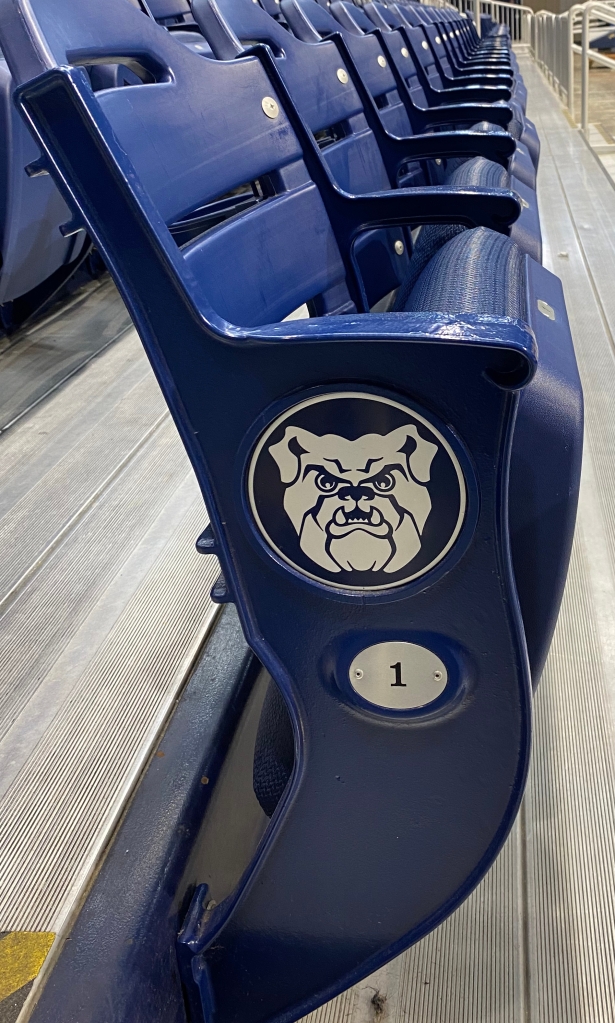
I have a deep affinity for college basketball and football venues. It’s no secret to Vicki, our daughters (trust me, they have childhood memories of trips to college campuses to prove it), or anyone who knows me very well. For me, it’s as if the place the game is played is as interesting as the game itself.
So imagine my excitement when I had the opportunity to visit the holy grail of all college basketball venues: Historic Hinkle Fieldhouse on the campus of Butler University on the north outskirts of Indianapolis. We had flown to Indy the night before, and were on our way to Valparaiso on Memorial Day weekend to meet our two-week-old grandson, Aksel, celebrate daughter Greta’s 34th birthday, and her 2-year-old daughter Ida’s birthday the following week.
“How about we visit Butler University on our way to Valparaiso?” I asked Vicki, before our trip. These questions are usually met with a rolling-of-the-eyes look. But because she was already familiar with the Butler gym –the two of us in March had watched several NCAA Tournament games played at Indianapolis-area arenas, including Hinkle – she was game.

I called the athletics department at Butler and asked if we could get a peek at the fieldhouse. I explained I was a recently retired Seattle Times journalist, and that it was a dream of mine to visit this most hallowed hardwood in basketball-crazed Indiana. An athletics representative named Kelsey said “sure, I’ll give you a tour.”

Kelsey and a security guard named Martin met us at the front entrance to the brick building, which is marked by a statue of the arena’s namesake, Tony Hinkle, a longtime coach and athletic director at Butler. We walked through the narrow concourse that surrounds the arena, gazing at the historic photos and trophies along the way. Then Martin unlocked the door that led us to the fieldhouse floor.
There she was, in all her glory, as I had imagined it. The arching steel roof trusses, and the windows at each of the end of the fieldhouse that prompted former Butler star guard Shelvin Mack to say there’s nothing like a Saturday afternoon game at Butler “with the sun coming in and everyone singing the Butler fight song.”

Hinkle Fieldhouse, which opened in 1927, is a gem. I could smell history in the air.
For more than 40 years, Hinkle was the stage for Indiana’s high-school basketball state tournament. In 1954, in a game that would define basketball in Indiana, tiny Milan High school (enrollment 161) beat Muncie Central for the state championship, which proved to be the inspiration for the iconic 1986 movie “Hoosiers.” In that era, all schools big and small competed in the same tournament. To put this game in perspective, this would be the state-of-Washington equivalent of La Conner High School beating Seattle’s Garfield High for the state title.
As I walked onto the floor of the old barn, which reminded me of the University of Washington’s original Hec Edmundson Pavilion built in the same era, I also imagined what this place felt like during Butler’s banner 2009-2010 season. That was the year the Bulldogs sprang onto the national stage under coach Brad Stevens, who would leave Butler a couple years later to become the head coach of the Boston Celtics and was just promoted to the team’s GM position. Mack and teammate Gordon Hayward led the little school from Indianapolis all the way to the national championship game against Duke in nearby Lucas Oil Stadium. Hayward missed a half-court shot at the buzzer that would have given Butler its first title.
Thanks to its Final Four run, Butler’s days of toiling in obscurity are in the rear-view mirror. The small, private university with an enrollment of just over 5,000 is big time now. The Bulldogs compete in the basketball-strong Big East Conference against the likes Georgetown, Xavier, Connecticut, Marquette, DePaul, Providence, Creighton and Villanova, which Martin the security guard said is Butler’s biggest rival.
But after visiting this most sacred cathedral of basketball, I can say this about Hinkle Fieldhouse: It has no rival.


